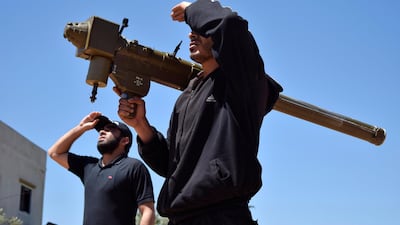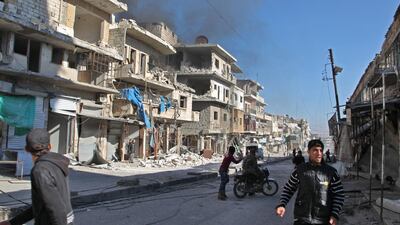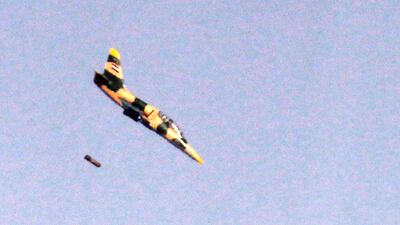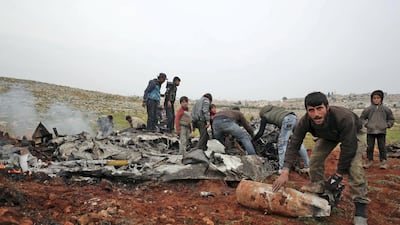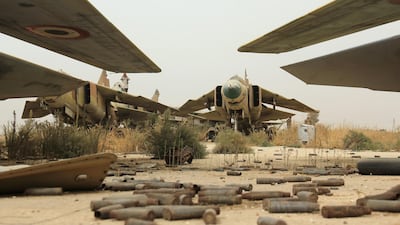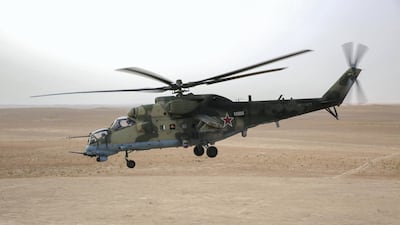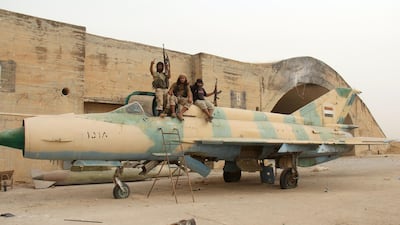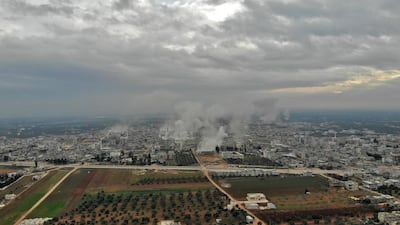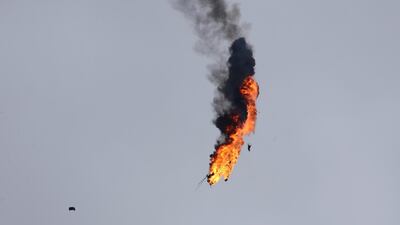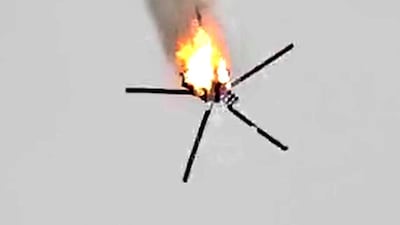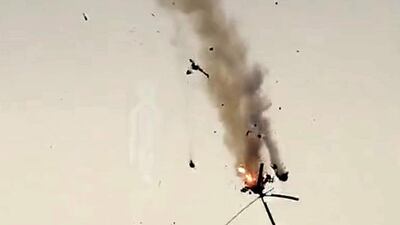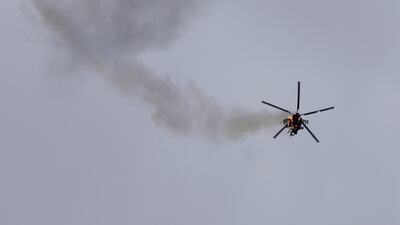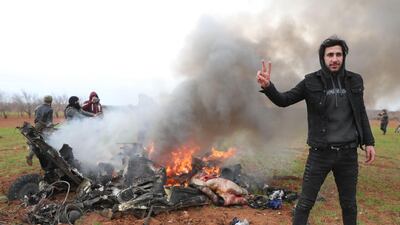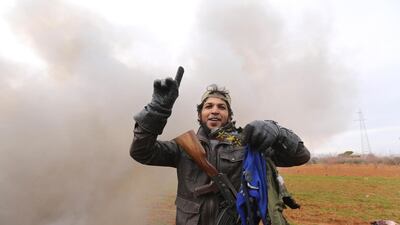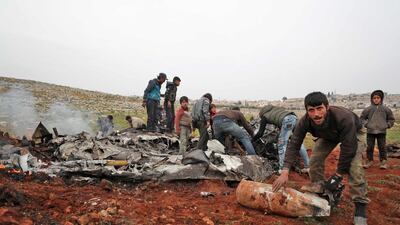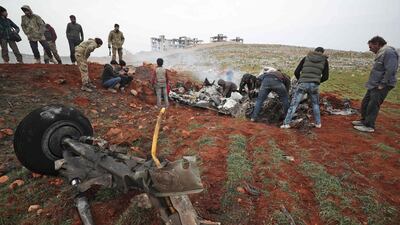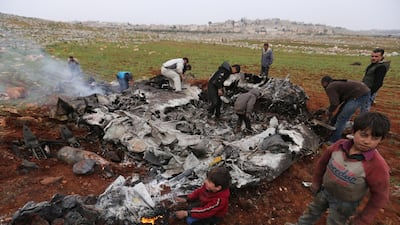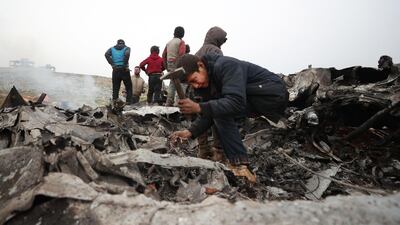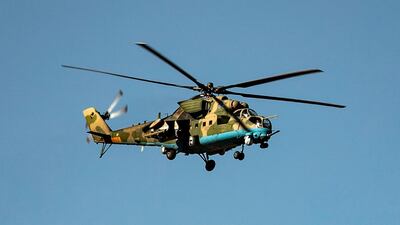For years, Syrian aircraft have inflicted untold damage on cities, towns and villages up and down the country. One of the most defining features of the nine-year conflict has been aerial bombardment – first by Syria’s air force, followed by Russian jets after President Vladimir Putin intervened in the country in 2015 saying he was fighting terrorism.
The immense destruction and paralysing fear wrought by these attacks has been immortalised in news report after news report, as well as a slew of widely successful Syrian-made films including For Sama and The Cave.
However, earlier this month two incidents suggested that rebels may have found something of a limited riposte.
Man-portable air defence systems, commonly referred to as Manpads, are a hand-held anti-aircraft weapons system capable of downing helicopters and some types of fighter jet.
A Syrian transport helicopter was downed by a Manpad missile over Idlib’s countryside on February 11, followed by another over the western Aleppo countryside on February 14.
Both of those shot down by rebel groups were Russian-designed transport helicopters, known as Mi-8/17s.
While the Syrian Air Force’s estimated fleet of approximately a dozen active Mi-8/17s are used in transport, reconnaissance and supply duties, they are probably most notorious for barrel bombing.
For years, the Syrian air force has flown helicopters over rebel-held areas and dropped oil drums and barrels packed with dynamite, shrapnel and gasoline onto buildings below with devastating effect.
But how crucial a loss were the two helicopters?
Estimates suggest that Syria had more than 460 fixed-wing or rotary combat aircraft and another 76 training aircraft before the outbreak of the uprising in 2011.
That arsenal included Russian or Soviet-made “L-39s, MiG-21s, MiG-23s, MiG-29s, Su-22s, and Su-24s for strike missions, and Mi-8/17s and Mi-24s for barrel bombing and strafing attacks,” according to a 2014 profile by the Washington Institute for Near East Policy.
A recent report by Tobias Schneider, a research fellow at Berlin's Global Public Policy Institute, estimates that there are “six to ten Mi-8/17 helicopters more or less consistently involved in the…barrel bombing campaign” that has led to thousands of civilian deaths.
The total helicopter arsenal in the air force may be closer to 50, although large numbers are believed to be out of service at any one time.
Researchers use a combination of open-source intelligence, satellite imagery and social media to build up a picture of the Syrian military’s hardware.
And while the findings cannot be exact to the last jet, it builds a clear picture of how Syria’s nine-year war has degraded the government’s air capabilities.
The two helicopters shot down are not the first. Rebels who previously stormed Syrian army bases commandeered anti-aircraft weapons and some groups received a limited number of Manpads from foreign backers.
Strikes by foreign states, including Israel and the United States, have also badly damaged several Syrian air bases and potentially aircraft too.
According to analyst Nicholas Heras, from the Institute for the Study of War think-tank in Washington DC, “approximately 30 per cent of the Syrian Arab Army’s aircraft is believed to have been destroyed by US action since the start of the conflict.”
The US Department of Defence previously claimed that an April 6, 2017 strike on the Shayrat air base, in response to the Khan Sheikhoun chemical weapons attack, destroyed “20 per cent of Syria’s operational aircraft.”
However, Mr Heras adds, Syria’s air force has been significantly bolstered by the Russian intervention of September 2015.
“One of the key features of the Russian intervention is that the Russians have brought…significant, advanced aircraft – particularly fighter jets.”
Despite the rare strikes against the helicopters this month, the pro-government bombing has not stopped.
After the second helicopter was downed, Syrian forces briefly adjusted their aerial tactics – opting to keep the more vulnerable helicopters back from opposition-held territory.
Perhaps most importantly for the 3 million civilians in the region, this brought a pause in barrel bombings.
Another attempted Manpad strike over the Idlib town of Saraqeb on February 26 reportedly missed its target, a Syrian jet, but did force the aircraft out of opposition airspace.
However, Russian and Syrian jets are still regularly bombarding both rebel positions and hitting civilian communities – including hundreds of thousands of displaced Syrians fleeing northward from the ongoing onslaught.
Company%20Profile
%3Cp%3E%3Cstrong%3ECompany%20name%3A%3C%2Fstrong%3E%20Hoopla%3Cbr%3E%3Cstrong%3EDate%20started%3A%20%3C%2Fstrong%3EMarch%202023%3Cbr%3E%3Cstrong%3EFounder%3A%3C%2Fstrong%3E%20Jacqueline%20Perrottet%3Cbr%3E%3Cstrong%3EBased%3A%3C%2Fstrong%3E%20Dubai%3Cbr%3E%3Cstrong%3ENumber%20of%20staff%3A%3C%2Fstrong%3E%2010%3Cbr%3E%3Cstrong%3EInvestment%20stage%3A%20%3C%2Fstrong%3EPre-seed%3Cbr%3E%3Cstrong%3EInvestment%20required%3A%3C%2Fstrong%3E%20%24500%2C000%3C%2Fp%3E%0A
UFC%20FIGHT%20NIGHT%3A%20SAUDI%20ARABIA%20RESULTS
%3Cp%3E%0D%3C%2Fp%3E%0A%3Cp%3E%3Cstrong%3EMain%20card%3Cbr%3EMiddleweight%3A%3C%2Fstrong%3E%0D%3Cbr%3ERobert%20Whittaker%20defeated%20Ikram%20Aliskerov%20via%20knockout%20(Round%201)%0D%3Cbr%3E%3Cstrong%3EHeavyweight%3A%3C%2Fstrong%3E%0D%3Cbr%3EAlexander%20Volkov%20def%20Sergei%20Pavlovich%20via%20unanimous%20decision%0D%3Cbr%3E%3Cstrong%3EMiddleweight%3A%3C%2Fstrong%3E%0D%3Cbr%3EKelvin%20Gastelum%20def%20Daniel%20Rodriguez%20via%20unanimous%20decision%0D%3Cbr%3E%3Cstrong%3EMiddleweight%3A%3C%2Fstrong%3E%0D%3Cbr%3EShara%20Magomedov%20def%20Antonio%20Trocoli%20via%20knockout%20(Round%203)%0D%3Cbr%3E%3Cstrong%3ELight%20heavyweight%3A%3C%2Fstrong%3E%0D%3Cbr%3EVolkan%20Oezdemir%20def%20Johnny%20Walker%20via%20knockout%20(Round%201)%0D%3Cbr%3E%3Cstrong%3EPreliminary%20Card%0D%3Cbr%3ELightweight%3A%3C%2Fstrong%3E%0D%3Cbr%3ENasrat%20Haqparast%20def%20Jared%20Gordon%20via%20split%20decision%0D%3Cbr%3E%3Cstrong%3EFeatherweight%3A%3C%2Fstrong%3E%0D%3Cbr%3EFelipe%20Lima%20def%20Muhammad%20Naimov%20via%20submission%20(Round%203)%0D%3Cbr%3E%3Cstrong%3EWelterweight%3A%3C%2Fstrong%3E%0D%3Cbr%3ERinat%20Fakhretdinov%20defeats%20Nicolas%20Dalby%20via%20split%20decision%0D%3Cbr%3E%3Cstrong%3EBantamweight%3A%3C%2Fstrong%3E%0D%3Cbr%3EMuin%20Gafurov%20def%20Kang%20Kyung-ho%20via%20unanimous%20decision%0D%3Cbr%3E%3Cstrong%3ELight%20heavyweight%3A%3C%2Fstrong%3E%0D%3Cbr%3EMagomed%20Gadzhiyasulov%20def%20Brendson%20Ribeiro%20via%20majority%20decision%0D%3Cbr%3E%3Cstrong%3EBantamweight%3A%3C%2Fstrong%3E%0D%3Cbr%3EChang%20Ho%20Lee%20def%20Xiao%20Long%20via%20split%20decision%3C%2Fp%3E%0A
MEDIEVIL%20(1998)
%3Cp%3E%3Cstrong%3EDeveloper%3A%3C%2Fstrong%3E%20SCE%20Studio%20Cambridge%3Cbr%3E%3Cstrong%3EPublisher%3A%3C%2Fstrong%3E%20Sony%20Computer%20Entertainment%3Cbr%3E%3Cstrong%3EConsole%3A%3C%2Fstrong%3E%20PlayStation%2C%20PlayStation%204%20and%205%3Cbr%3E%3Cstrong%3ERating%3A%3C%2Fstrong%3E%203.5%2F5%3C%2Fp%3E%0A
Brief scores:
Juventus 3
Dybala 6', Bonucci 17', Ronaldo 63'
Frosinone 0
UAE currency: the story behind the money in your pockets
Aldar Properties Abu Dhabi T10
*November 15 to November 24
*Venue: Zayed Cricket Stadium, Abu Dhabi
*Tickets: Start at Dh10, from ttensports.com
*TV: Ten Sports
*Streaming: Jio Live
*2017 winners: Kerala Kings
*2018 winners: Northern Warriors
Four motivational quotes from Alicia's Dubai talk
“The only thing we need is to know that we have faith. Faith and hope in our own dreams. The belief that, when we keep going we’re going to find our way. That’s all we got.”
“Sometimes we try so hard to keep things inside. We try so hard to pretend it’s not really bothering us. In some ways, that hurts us more. You don’t realise how dishonest you are with yourself sometimes, but I realised that if I spoke it, I could let it go.”
“One good thing is to know you’re not the only one going through it. You’re not the only one trying to find your way, trying to find yourself, trying to find amazing energy, trying to find a light. Show all of yourself. Show every nuance. All of your magic. All of your colours. Be true to that. You can be unafraid.”
“It’s time to stop holding back. It’s time to do it on your terms. It’s time to shine in the most unbelievable way. It’s time to let go of negativity and find your tribe, find those people that lift you up, because everybody else is just in your way.”
Silent Hill f
Publisher: Konami
Platforms: PlayStation 5, Xbox Series X/S, PC
Rating: 4.5/5
Ferrari 12Cilindri specs
Engine: naturally aspirated 6.5-liter V12
Power: 819hp
Torque: 678Nm at 7,250rpm
Price: From Dh1,700,000
Available: Now
The biog
Job: Fitness entrepreneur, body-builder and trainer
Favourite superhero: Batman
Favourite quote: We must become the change we want to see, by Mahatma Gandhi.
Favourite car: Lamborghini
Auron Mein Kahan Dum Tha
Starring: Ajay Devgn, Tabu, Shantanu Maheshwari, Jimmy Shergill, Saiee Manjrekar
Director: Neeraj Pandey
Rating: 2.5/5
Islamophobia definition
A widely accepted definition was made by the All Party Parliamentary Group on British Muslims in 2019: “Islamophobia is rooted in racism and is a type of racism that targets expressions of Muslimness or perceived Muslimness.” It further defines it as “inciting hatred or violence against Muslims”.
SPECS
Engine: Two-litre four-cylinder turbo
Power: 235hp
Torque: 350Nm
Transmission: Nine-speed automatic
Price: From Dh167,500 ($45,000)
On sale: Now
Key findings of Jenkins report
- Founder of the Muslim Brotherhood, Hassan al Banna, "accepted the political utility of violence"
- Views of key Muslim Brotherhood ideologue, Sayyid Qutb, have “consistently been understood” as permitting “the use of extreme violence in the pursuit of the perfect Islamic society” and “never been institutionally disowned” by the movement.
- Muslim Brotherhood at all levels has repeatedly defended Hamas attacks against Israel, including the use of suicide bombers and the killing of civilians.
- Laying out the report in the House of Commons, David Cameron told MPs: "The main findings of the review support the conclusion that membership of, association with, or influence by the Muslim Brotherhood should be considered as a possible indicator of extremism."
Heather, the Totality
Matthew Weiner,
Canongate
Profile of Bitex UAE
Date of launch: November 2018
Founder: Monark Modi
Based: Business Bay, Dubai
Sector: Financial services
Size: Eight employees
Investors: Self-funded to date with $1m of personal savings
How to apply for a drone permit
- Individuals must register on UAE Drone app or website using their UAE Pass
- Add all their personal details, including name, nationality, passport number, Emiratis ID, email and phone number
- Upload the training certificate from a centre accredited by the GCAA
- Submit their request
What are the regulations?
- Fly it within visual line of sight
- Never over populated areas
- Ensure maximum flying height of 400 feet (122 metres) above ground level is not crossed
- Users must avoid flying over restricted areas listed on the UAE Drone app
- Only fly the drone during the day, and never at night
- Should have a live feed of the drone flight
- Drones must weigh 5 kg or less
Race%20card
%3Cp%3E6pm%3A%20Al%20Maktoum%20Challenge%20Round%201%20%E2%80%93%20Group%201%20(PA)%20%2450%2C000%20(Dirt)%201%2C600m%3Cbr%3E6.35pm%3A%20Dubai%20Racing%20Club%20Classic%20%E2%80%93%20Handicap%20(TB)%20%24100%2C000%20(D)%202%2C410m%3Cbr%3E7.10pm%3A%20Dubawi%20Stakes%20%E2%80%93%20Group%203%20(TB)%20%24150%2C000%20(D)%201%2C200m%3Cbr%3E7.45pm%3A%20Jumeirah%20Classic%20Trial%20%E2%80%93%20Conditions%20(TB)%20%24150%2C000%20(Turf)%201%2C400m%3Cbr%3E8.20pm%3A%20Al%20Maktoum%20Challenge%20Round%201%20%E2%80%93%20Group%202%20(TB)%20%24250%2C000%20(D)%201%2C600m%3Cbr%3E8.55pm%3A%20Al%20Fahidi%20Fort%20%E2%80%93%20Group%202%20(TB)%20%24180%2C000%20(T)%201%2C400m%3Cbr%3E9.30pm%3A%20Ertijaal%20Dubai%20Dash%20%E2%80%93%20Listed%20(TB)%20%24100%2C000%20(T)%201%2C000m%3C%2Fp%3E%0A
How they line up for Sunday's Australian Grand Prix
1 Lewis Hamilton, Mercedes
2 Kimi Raikkonen, Ferrari
3 Sebastian Vettel, Ferrari
4 Max Verstappen, Red Bull
5 Kevin Magnussen, Haas
6 Romain Grosjean, Haas
7 Nico Hulkenberg, Renault
*8 Daniel Ricciardo, Red Bull
9 Carlos Sainz, Renault
10 Valtteri Bottas, Mercedes
11 Fernando Alonso, McLaren
12 Stoffel Vandoorne, McLaren
13 Sergio Perez, Force India
14 Lance Stroll, Williams
15 Esteban Ocon, Force India
16 Brendon Hartley, Toro Rosso
17 Marcus Ericsson, Sauber
18 Charles Leclerc, Sauber
19 Sergey Sirotkin, Williams
20 Pierre Gasly, Toro Rosso
* Daniel Ricciardo qualified fifth but had a three-place grid penalty for speeding in red flag conditions during practice
World record transfers
1. Kylian Mbappe - to Real Madrid in 2017/18 - €180 million (Dh770.4m - if a deal goes through)
2. Paul Pogba - to Manchester United in 2016/17 - €105m
3. Gareth Bale - to Real Madrid in 2013/14 - €101m
4. Cristiano Ronaldo - to Real Madrid in 2009/10 - €94m
5. Gonzalo Higuain - to Juventus in 2016/17 - €90m
6. Neymar - to Barcelona in 2013/14 - €88.2m
7. Romelu Lukaku - to Manchester United in 2017/18 - €84.7m
8. Luis Suarez - to Barcelona in 2014/15 - €81.72m
9. Angel di Maria - to Manchester United in 2014/15 - €75m
10. James Rodriguez - to Real Madrid in 2014/15 - €75m
In numbers: China in Dubai
The number of Chinese people living in Dubai: An estimated 200,000
Number of Chinese people in International City: Almost 50,000
Daily visitors to Dragon Mart in 2018/19: 120,000
Daily visitors to Dragon Mart in 2010: 20,000
Percentage increase in visitors in eight years: 500 per cent
The specs
Engine: Four electric motors, one at each wheel
Power: 579hp
Torque: 859Nm
Transmission: Single-speed automatic
Price: From Dh825,900
On sale: Now
Men's football draw
Group A: UAE, Spain, South Africa, Jamaica
Group B: Bangladesh, Serbia, Korea
Group C: Bharat, Denmark, Kenya, USA
Group D: Oman, Austria, Rwanda
AUSTRALIA SQUAD
Steve Smith (capt), David Warner, Cameron Bancroft, Jackson Bird, Pat Cummins, Peter Handscomb, Josh Hazlewood, Usman Khawaja, Nathan Lyon, Shaun Marsh, Tim Paine, Chadd Sayers, Mitchell Starc.
Mental%20health%20support%20in%20the%20UAE
%3Cp%3E%E2%97%8F%20Estijaba%20helpline%3A%208001717%3Cbr%3E%E2%97%8F%20UAE%20Ministry%20of%20Health%20and%20Prevention%20hotline%3A%20045192519%3Cbr%3E%E2%97%8F%20UAE%20Mental%20health%20support%20line%3A%20800%204673%20(Hope)%3Cbr%3EMore%20information%20at%20hope.hw.gov.ae%3C%2Fp%3E%0A
Meg%202%3A%20The%20Trench
%3Cp%3E%3Cstrong%3EDirector%3A%20%3C%2Fstrong%3EBen%20Wheatley%3Cbr%3E%3Cstrong%3EStars%3A%20%3C%2Fstrong%3EJason%20Statham%2C%20Jing%20Wu%2C%20Cliff%20Curtis%2C%20Page%20Kennedy%2C%20Cliff%20Curtis%2C%20Melissanthi%20Mahut%20and%20Shuya%20Sophia%20Cai%3Cbr%3E%3Cstrong%3ERating%3A%20%3C%2Fstrong%3E2%2F5%3C%2Fp%3E%0A
What are the influencer academy modules?
- Mastery of audio-visual content creation.
- Cinematography, shots and movement.
- All aspects of post-production.
- Emerging technologies and VFX with AI and CGI.
- Understanding of marketing objectives and audience engagement.
- Tourism industry knowledge.
- Professional ethics.
Difference between fractional ownership and timeshare
Although similar in its appearance, the concept of a fractional title deed is unlike that of a timeshare, which usually involves multiple investors buying “time” in a property whereby the owner has the right to occupation for a specified period of time in any year, as opposed to the actual real estate, said John Peacock, Head of Indirect Tax and Conveyancing, BSA Ahmad Bin Hezeem & Associates, a law firm.
From Zero
Artist: Linkin Park
Label: Warner Records
Number of tracks: 11
Rating: 4/5
AGL AWARDS
Golden Ball - best Emirati player: Khalfan Mubarak (Al Jazira)
Golden Ball - best foreign player: Igor Coronado (Sharjah)
Golden Glove - best goalkeeper: Adel Al Hosani (Sharjah)
Best Coach - the leader: Abdulaziz Al Anbari (Sharjah)
Fans' Player of the Year: Driss Fetouhi (Dibba)
Golden Boy - best young player: Ali Saleh (Al Wasl)
Best Fans of the Year: Sharjah
Goal of the Year: Michael Ortega (Baniyas)
Who's who in Yemen conflict
Houthis: Iran-backed rebels who occupy Sanaa and run unrecognised government
Yemeni government: Exiled government in Aden led by eight-member Presidential Leadership Council
Southern Transitional Council: Faction in Yemeni government that seeks autonomy for the south
Habrish 'rebels': Tribal-backed forces feuding with STC over control of oil in government territory
What is graphene?
Graphene is extracted from graphite and is made up of pure carbon.
It is 200 times more resistant than steel and five times lighter than aluminum.
It conducts electricity better than any other material at room temperature.
It is thought that graphene could boost the useful life of batteries by 10 per cent.
Graphene can also detect cancer cells in the early stages of the disease.
The material was first discovered when Andre Geim and Konstantin Novoselov were 'playing' with graphite at the University of Manchester in 2004.
